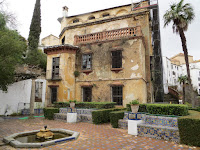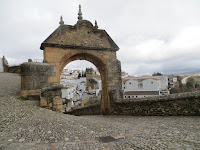 |
| Ronda |
 |
| Ronda |
 |
| Ronda |
 |
| Ronda |
While the eventual winners, the Nationalists, are said to have killed significantly more people with ther 'policy of terror', it is rumoured that here in Ronda, the Republican side threw the Falangists off the cliffs. This was later included as a scene in Ernest Hemingway's For Whom The Bell Tolls.
The name Puenta Nueva, or New Bridge, is a little misleading these days, as it was actually constructed in 1793 to link together the two parts of the town on either side of the gorge. The north side has the newer area of town, while the south has La Ciudad, the older area.
The older side is certainly worth wandering around. As you would expect, it has some of the more touristy shops, but a few nice ones too.
One in particular held our attention for a while, as it had a number of old wooden doors and window shutters for sale, some of which, like those that still remain on a few of the buildings, were beautiful.
We considered them, but sadly decided that the prices were too inflated, probably as a result of this being such a popular tourist destination.
 |
| Ronda |
One in particular held our attention for a while, as it had a number of old wooden doors and window shutters for sale, some of which, like those that still remain on a few of the buildings, were beautiful.
We considered them, but sadly decided that the prices were too inflated, probably as a result of this being such a popular tourist destination.
 |
| Palacio Mondragon, Ronda |
We took a look in the gardens of Palacio Mondragon, which were pleasant enough, and we have read that the house itself is supposed to be good too if you are there when it is open.
 |
| Arab Baths, Ronda |
 |
| Arab Baths, Ronda |
If you can face the walk back up the hill, it is well worth walking down to the Arab Baths, a 13th century Moorish Hammam, that is very well preserved. We found the self guided tour interesting and informative.
 |
| Arab Baths, Ronda |
 |
| Ronda |
 |
| Bullring Museum, Ronda |
It was here, in the early 1720's that bullfighter Fransisco Romero started both the use of the muleta (the red cape of a stick that is used towards the end of the fight to conceal the sword) and the practice of fighting the bull on foot, rather than on horseback.
The bull ring here is still used once a year for the Feria Goyesca, where they celebrate the bullfight and the works of Fransisco Goya, as participants dress in the style of clothes that were worn in his paintings. However for the rest of the year, the bullring is just a museum.
 |
| Bullring Museum, Ronda |
So, despite our misgivings, we decided to visit the museum. It is actually quite good, although some of the information could be better. When you look at the costumes, artwork and other accoutrements of the sport, I can understand some of the appeal it has. The flamboyance and flair is undeniable, and were it not for the fact that they bleed, tease and kill a bull, I could probably quite enjoy it. But it does involve all of those things, so I remain firmly against it.
 |
| Bullring Museum, Ronda |
 |
| Bullring Museum, Ronda |
 |
| Bullring Museum, Ronda |
 |
| Ronda |
 |
| Ronda |
 |
| Ronda |
 |
| Ronda |






No comments:
Post a Comment
We like to hear from you too, so please leave us a message here. We are also happy to answer any questions if we can help. Comments are moderated so will not appear straight away and there could be some delay in replying if we are travelling.